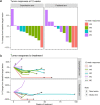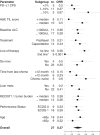A phase Ib trial of pembrolizumab plus paclitaxel or flat-dose capecitabine in 1st/2nd line metastatic triple-negative breast cancer
- PMID: 37344474
- PMCID: PMC10284878
- DOI: 10.1038/s41523-023-00541-2
A phase Ib trial of pembrolizumab plus paclitaxel or flat-dose capecitabine in 1st/2nd line metastatic triple-negative breast cancer
Abstract
Chemoimmunotherapy with anti-programmed cell death 1/ligand 1 and cytotoxic chemotherapy is a promising therapeutic modality for women with triple-negative breast cancer, but questions remain regarding optimal chemotherapy backbone and biomarkers for patient selection. We report final outcomes from a phase Ib trial evaluating pembrolizumab (200 mg IV every 3 weeks) with either weekly paclitaxel (80 mg/m2 weekly) or flat-dose capecitabine (2000 mg orally twice daily for 7 days of every 14-day cycle) in the 1st/2nd line setting. The primary endpoint is safety (receipt of 2 cycles without grade III/IV toxicities requiring discontinuation or ≥21-day delays). The secondary endpoint is efficacy (week 12 objective response). Exploratory aims are to characterize immunologic effects of treatment over time, and to evaluate novel biomarkers. The trial demonstrates that both regimens meet the pre-specified safety endpoint (paclitaxel: 87%; capecitabine: 100%). Objective response rate is 29% for pembrolizumab/paclitaxel (n = 4/13, 95% CI: 10-61%) and 43% for pembrolizumab/capecitabine (n = 6/14, 95% CI: 18-71%). Partial responses are observed in two subjects with chemo-refractory metaplastic carcinoma (both in capecitabine arm). Both regimens are associated with significant peripheral leukocyte contraction over time. Response is associated with clinical PD-L1 score, non-receipt of prior chemotherapy, and the H&E stromal tumor-infiltrating lymphocyte score, but also by a novel 27 gene IO score and spatial biomarkers (lymphocyte spatial skewness). In conclusion, pembrolizumab with paclitaxel or capecitabine is safe and clinically active. Both regimens are lymphodepleting, highlighting the competing immunostimulatory versus lymphotoxic effects of cytotoxic chemotherapy. Further exploration of the IO score and spatial TIL biomarkers is warranted. The clinical trial registration is NCT02734290.
© 2023. The Author(s).
Conflict of interest statement
D.B.P.—speaker’s bureau honoraria- Genentech, Novartis, Clinical Care Options, Oncocyte; Research funds: WindMIL, Brooklyn Immunotherapeutics, Merck, Bristol-Myers Squibb, IMV; consulting fees: Merck, Gilead, Biotheranostics, Puma, Lilly, Sanofi, NGM Bio, Sanford Burnam Prebys, AstraZeneca. J.P.—none. B.C.—none. I.K.—none. K.S.—none. N.M.—none. S.M.—none. Y.W.—none. Y.K.—Research support from Bristol Myers Squibb (BMS), GlaxoSmithKline, Shimadzu. V.C.—none. W.L.R.—Please update this: Research support from Bristol-Myers Squibb, GlaxoSmithKline, MiNA Therapeutics, Inhibrx, Veana Therapeutics, Shimadzu, OncoSec Medical, Turn Biotechnologies, CanWell Pharma, Galecto, and Calibr. Patents/Licensing fees: Galectin Therapeutics. Advisory Boards: Medicenna, Vesselon. Z.S.—acquisition of data. M.M.—none. M.C.—acquisition of data. A.C.—none. A.A.—None. R.B.—Institutional research funding from Seattle Genetics, Merck, Takeda, Pfizer; Consulting role: Biotheranostics, Pfizer, AstraZeneca, Seattle Genetics, Gilead, Novartis; Speaker: Eli Lilly, Seattle Genetics, WebMD, MJH Healthcare. P.M.—none. M.E.-M.—none. D.P.—none. I.E.C.—none. L.B.—none. R.S.S.—Employment: Oncocyte. T.J.N. – Employment: Oncocyte. K.M.- Employment: Oncocyte. V.R.—None. B.B.—None. W.J.U.—Safety advisory board: Astra Zeneca. H.L.M.—Research support: Merck, Lilly, BMS. Advisory/consultancy Merck, Lilly, Spectrum Pharmaceuticals, Amgen, Immunomedics, Pfizer, Genentech, BMS, Genomic Health, ZIOPHARM Oncology; Travel/expenses: Merck, Spectrum Pharmaceuticals, Lilly, Amgen, Immunomedics, Pfizer, Genentech Puma Biotechnology; Speaker Bureau: Lilly. Institutional funding: Merck, Lilly, BMS, ZIOPHARM Oncology.
Figures







References
-
- Schmid, P. et al. Atezolizumab and Nab-Paclitaxel in Advanced Triple-Negative Breast Cancer. N. Engl. J. Med.10.1056/NEJMoa1809615 (2018). - PubMed
-
- Schmid P, et al. IMpassion130: updated overall survival (OS) from a global, randomized, double-blind, placebo-controlled, Phase III study of atezolizumab (atezo) + nab-paclitaxel (nP) in previously untreated locally advanced or metastatic triple-negative breast cancer (mTNBC) J. Clin. Oncol. 2019;37:1003. doi: 10.1200/JCO.2019.37.15_suppl.1003. - DOI
-
- Schmid P, et al. Atezolizumab plus nab-paclitaxel as first-line treatment for unresectable, locally advanced or metastatic triple-negative breast cancer (IMpassion130): updated efficacy results from a randomised, double-blind, placebo-controlled, phase 3 trial. Lancet Oncol. 2020;21:44–59. doi: 10.1016/S1470-2045(19)30689-8. - DOI - PubMed
Associated data
LinkOut - more resources
Full Text Sources
Medical
Molecular Biology Databases
Research Materials

